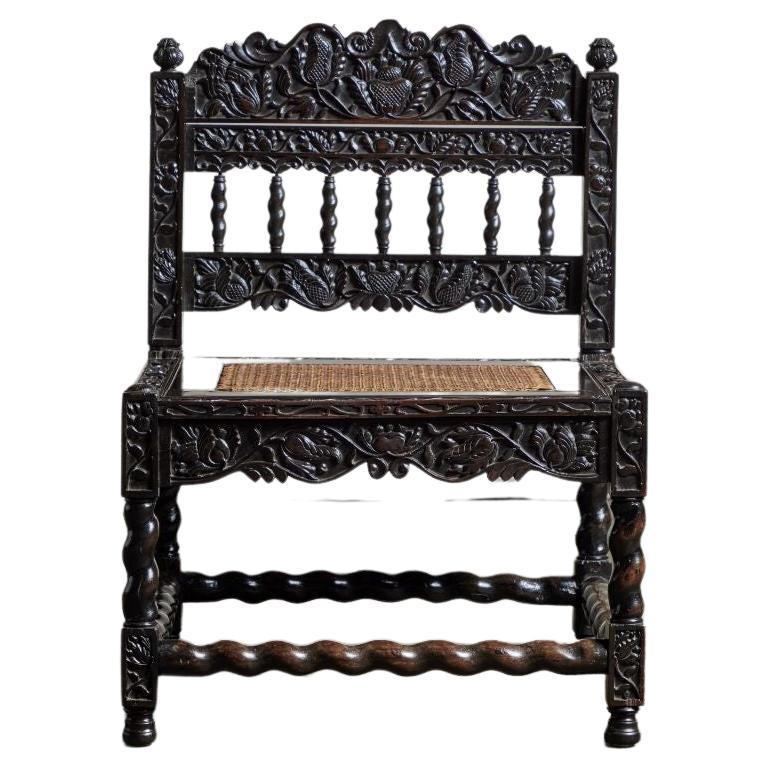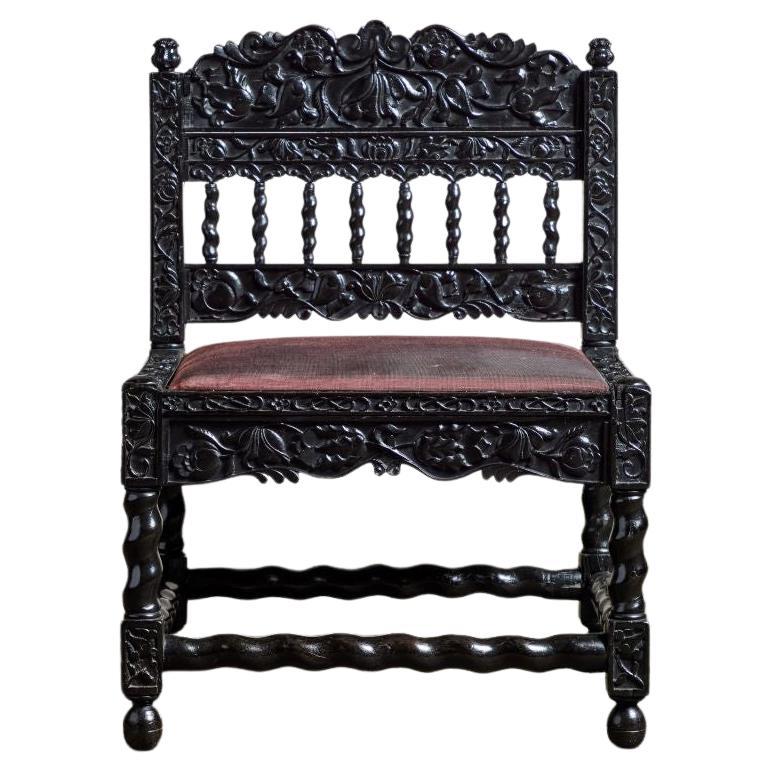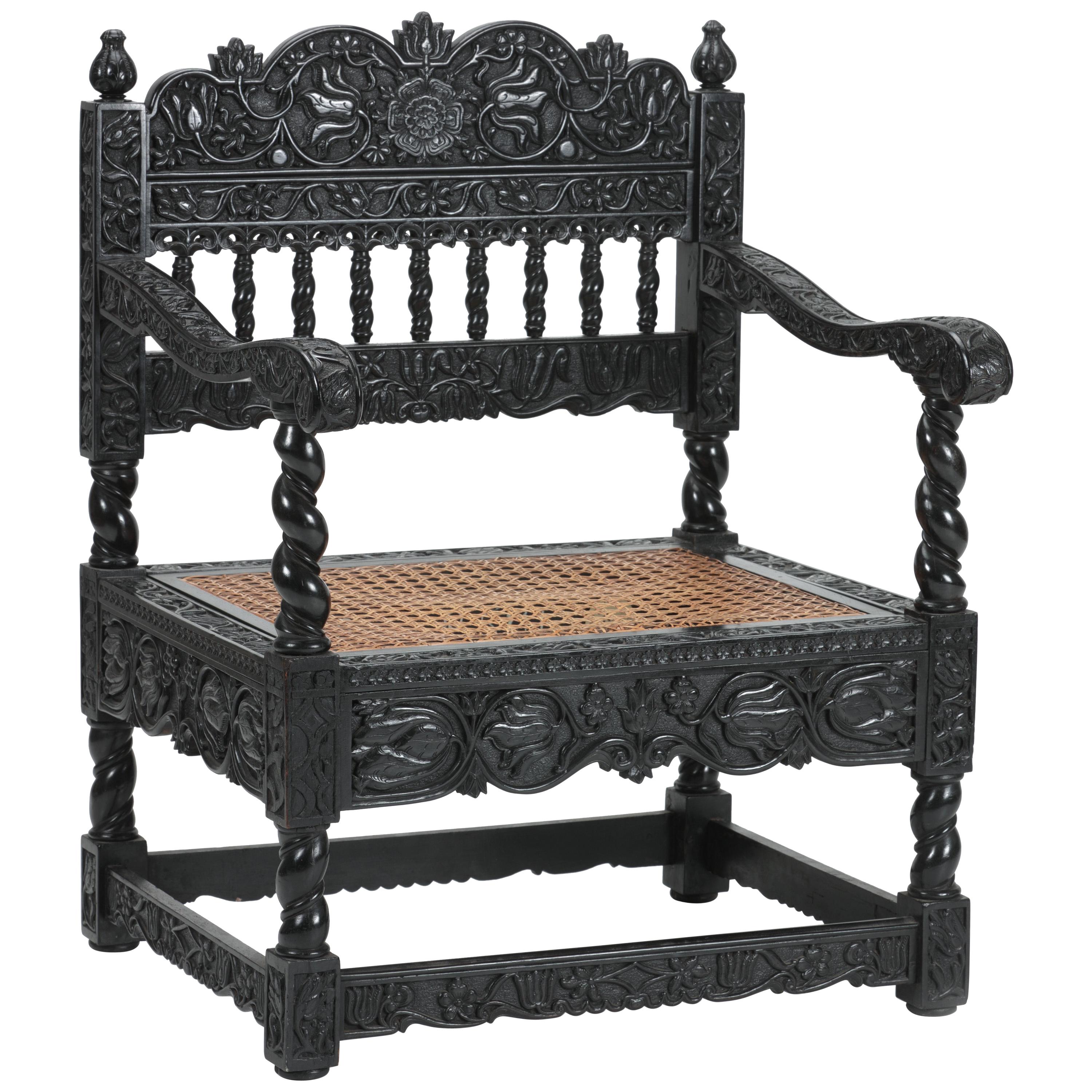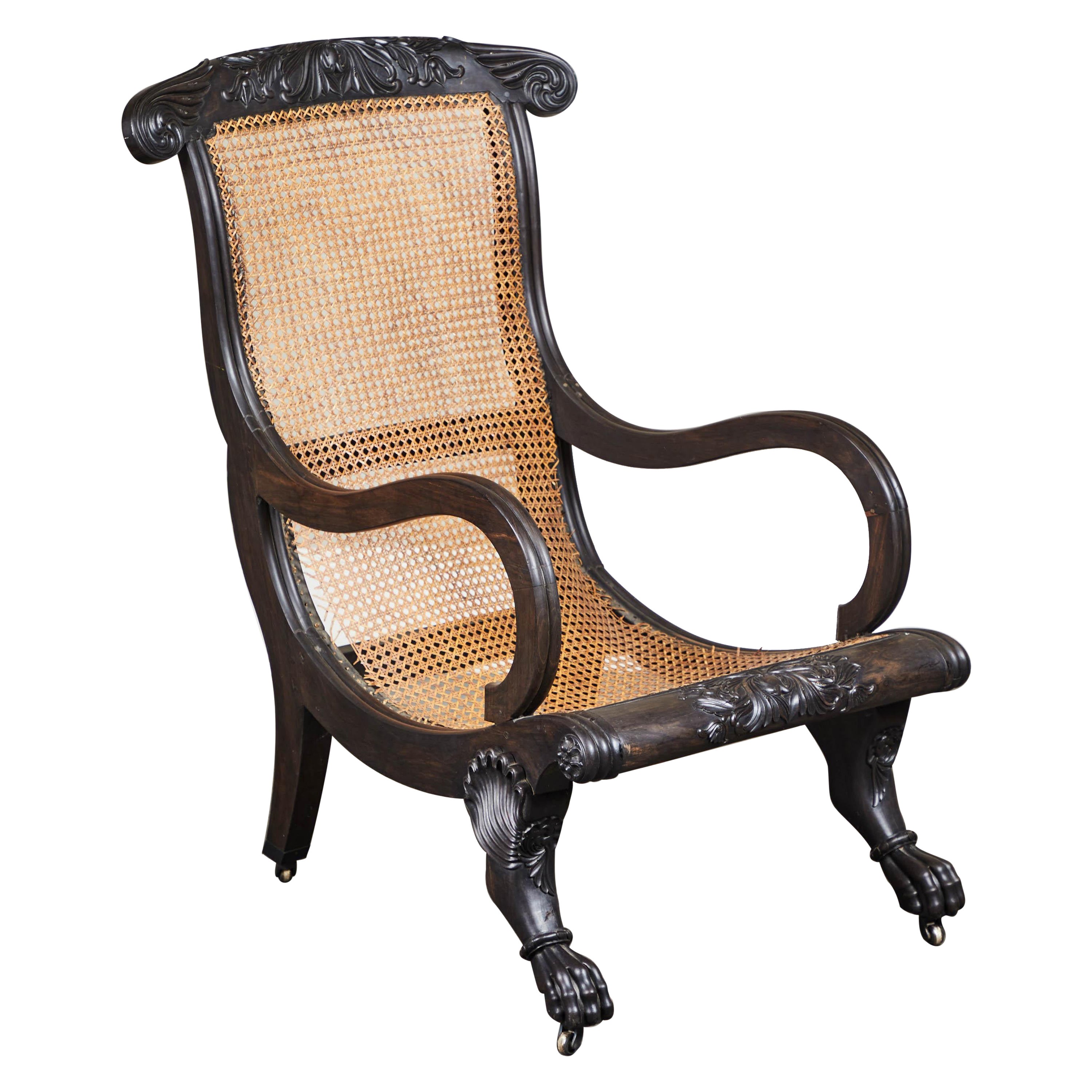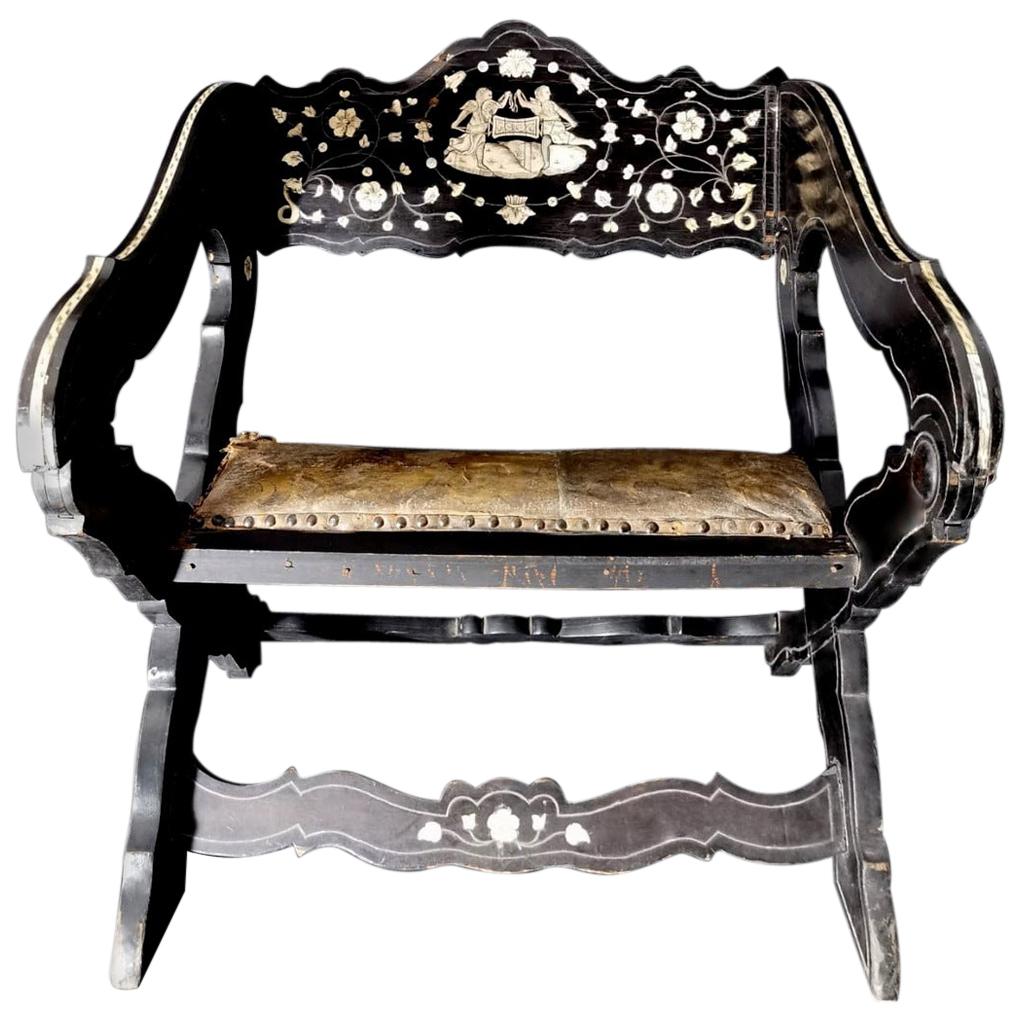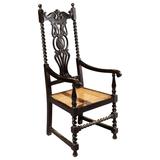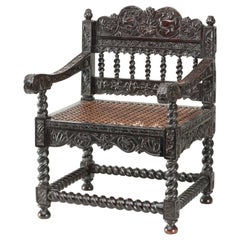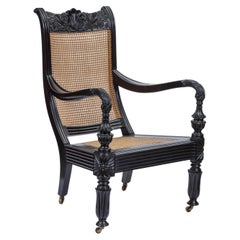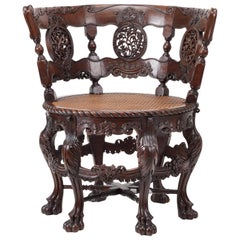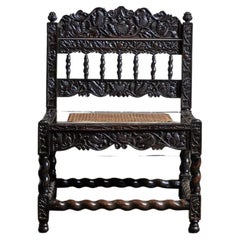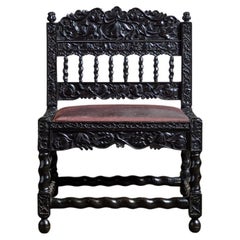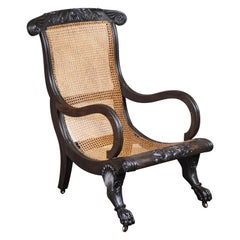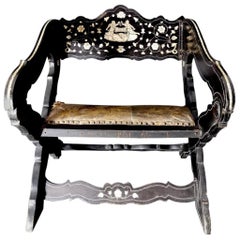Items Similar to 17th Cent. Dutch Colonial Ebony Chair Formerly Owned by the Duke of Westminster
Want more images or videos?
Request additional images or videos from the seller
1 of 5
17th Cent. Dutch Colonial Ebony Chair Formerly Owned by the Duke of Westminster
$37,142.45
£27,650.14
€31,000
CA$50,875.87
A$56,585.08
CHF 29,546.97
MX$688,580.19
NOK 377,359.87
SEK 353,896.99
DKK 235,992.18
Shipping
Retrieving quote...The 1stDibs Promise:
Authenticity Guarantee,
Money-Back Guarantee,
24-Hour Cancellation
About the Item
An Indian ebony low chair formerly owned by the Duke of Westminster
Coromandel coast, possibly Madras, 1680-1700
Overall densely carved with an array of mermaids, birds, fish, mythological figures and floral and vine motifs, the back-rails are centered by a parrot (the attribute of Kama, the Hindu god of love) below a scallop shell (an attribute of Aphrodite/Venus) with a fleur-de-lis (a symbol of the Virgin Mary), the shell supported by two small human figures and a pair of mermaids, another Western element, but also a representation of the Hindu snake goddess Nagini, with crouching figures as finials, reminiscent of deity figures, with cane seatings.
H. 85 x W. 50.5 x D. 45 cm
Height of seat 41.5 cm
Note:
An identical chair is illustrated in Het Hollandsche Koloniale Barokmeubel, Dr. V. I. van de Wall, .1939, fig. 26. The Provenance of that chair is given as the Duke of Westminster, Eaton Hall, Chester. Before restoration the present pair had identical upholstered seats and the same casters as the chair of the Duke of Westminster. Therefore it seems safe to assume that the provenance of the present pair also is the Duke of Westminster, Eaton Hall in Chester. In the seat rails of the present chairs both are numbered II and III respectively, so they probably once belonged to a larger set in Eaton Hall. This type of chair usually turns up in England and seldom in Holland although they were also ordered by the Dutch on the Coromandel Coast of India. Possibly the Hindu motives of animals and humans in the carvings of these “Kust stoelen” were eventually not greatly appreciated in Muslin/Calvinist Java/Batavia. These high points in ebony furniture making were made by Hindu craftsmen in South India converted to Roman Catholicism by the Portuguese in the 16th and 17th centuries. These furniture makers, with their origins in the Hindu world, combined Hindu and Christian motives in a manner which was not seen again in furniture from India after the 17th century.
As in other known examples, the carving is in the round. The carvings on these two chairs bear a close resemblance to the carving of the head- and foot-boards of the ebony rocking cradle in the Rijksmuseum Amsterdam (BK-1966-48, illustrated in: Asia in Amsterdam, 2015, cat. 26, p.108).
- Dimensions:Height: 33.47 in (85 cm)Width: 19.89 in (50.5 cm)Depth: 17.72 in (45 cm)Seat Height: 16.34 in (41.5 cm)
- Style:Dutch Colonial (Of the Period)
- Materials and Techniques:
- Place of Origin:
- Period:Late 17th Century
- Date of Manufacture:1680-1700
- Condition:Wear consistent with age and use.
- Seller Location:Amsterdam, NL
- Reference Number:1stDibs: LU5458220859742
About the Seller
5.0
Recognized Seller
These prestigious sellers are industry leaders and represent the highest echelon for item quality and design.
Established in 1985
1stDibs seller since 2020
23 sales on 1stDibs
Typical response time: 2 hours
- ShippingRetrieving quote...Shipping from: Amsterdam, Netherlands
- Return Policy
Authenticity Guarantee
In the unlikely event there’s an issue with an item’s authenticity, contact us within 1 year for a full refund. DetailsMoney-Back Guarantee
If your item is not as described, is damaged in transit, or does not arrive, contact us within 7 days for a full refund. Details24-Hour Cancellation
You have a 24-hour grace period in which to reconsider your purchase, with no questions asked.Vetted Professional Sellers
Our world-class sellers must adhere to strict standards for service and quality, maintaining the integrity of our listings.Price-Match Guarantee
If you find that a seller listed the same item for a lower price elsewhere, we’ll match it.Trusted Global Delivery
Our best-in-class carrier network provides specialized shipping options worldwide, including custom delivery.More From This Seller
View AllDutch Colonial 17th Century Ebony Armchair, India/Indonesia/Sri Lanka
Located in Amsterdam, NL
An unusual Indian half-relief carved ebony armchair
Coromandel coast, 1680-1700
?
Throughout carved with floral and vine motifs, the back rail with a central peony and ...
Category
Antique Late 17th Century Indian Dutch Colonial Furniture
Materials
Rattan, Ebony
An extremely rare, possibly unique, Sri Lankan ebony child's armchair
Located in Amsterdam, NL
Probably Sri Lanka, 2nd half 17th century
H. 55 x W. 40.5 x D. 40.5 cm
Seat height 27.5 cm
The chair is overall densely carved with a scrolling flower motif on four connected turne...
Category
Antique Late 17th Century Indonesian Dutch Colonial Furniture
Materials
Ebony
A Sri Lankan ebony and cane ‘Easy chair’ or 'planter's chair'
Located in Amsterdam, NL
A Sri Lankan ebony and cane ‘Easy chair’ or 'planter's chair'
Galle, mid-19th century
H. 101 x W. 61 x D. 78.5 cm
H. 38.5 cm (seat height)
Ebony f...
Category
Antique Mid-19th Century Sri Lankan Furniture
Materials
Ebony
Sri Lankan Mãrã or East Indian Walnut ‘Burgomaster’ Chair
Located in Amsterdam, NL
A Sri Lankan mãrã or East Indian walnut ‘Burgomaster’ chair
Galle, early 19th century
Measures: H. 81.5 x W. 74 cm / seat height 45.5 cm / seat di...
Category
Antique Early 19th Century Sri Lankan Dutch Colonial Furniture
Materials
Rattan, Hardwood
Pair of Colonial Hardwood Side Chairs with Rattan Seats, 18th Century
Located in Amsterdam, NL
A pair of hardwood, possibly Intsia Bijuga, side chairs, first half of the 18th century.
Indonesia, Jakarta (Batavia) or India, first half ...
Category
Antique Early 18th Century Indonesian Dutch Colonial Furniture
Materials
Hardwood
Dutch Colonial Teak Round Back Chair, Late 18th Century
Located in Amsterdam, NL
AN INDONESIAN TEAK WOOD ROUND-BACK CHAIR
Indonesia/Jakarta (Batavia), late 18th century
The wood elegantly carved and curved, the round-back and seating with cane.
H. 87 x W. 61 cm
Seat height 42.5 cm
Note:
Round back chairs, starting with the burgomaster chairs...
Category
Antique Late 18th Century Indian Dutch Colonial Furniture
Materials
Rattan, Teak
You May Also Like
17th Century Dutch Colonial Ebony Side Chair
Located in San Marino, CA
Dutch Colonial Ebony side chairs from the late 17th/early 18th century.
Category
Antique Early 17th Century Dutch Side Chairs
Materials
Wood
17th Century Dutch Colonial Ebony Side Chair
Located in San Marino, CA
Dutch Colonial Ebony side chairs from the late 17th/Early 18th Century.
Category
Antique Late 17th Century Dutch Side Chairs
Materials
Wood
19th Century British Colonial/Regency Ebony Chair
Located in San Marino, CA
A 19th century British Colonial Ebony chair with carved back and feet. Caned seat with scrolled arms.
Category
Antique Mid-19th Century Sri Lankan Regency Armchairs
Materials
Rattan, Ebony
Spanish Ancient Ebony Chair with Cordova Leather
Located in Prato, Tuscany
We kindly suggest you read the whole description, because with it we try to give you detailed technical and historical information to guarantee the authenticity of our objects.
Rare and unique wooden...
Category
Antique Late 18th Century Spanish Spanish Colonial Chairs
Materials
Leather, Ebony
$1,725 Sale Price
20% Off
19th Century Ebonised Anglo Indian High Back Chair
Located in London, by appointment only
An unusual high back chair, the ebonised wooden frame with spiral supports and unusual pierced splat, the swept arms above baluster supports, cane seats and barely twist...
Category
Antique 19th Century Indian Anglo-Indian Chairs
Hand Carved Black Stained Oak Gothic Revival Side Chair w/ Wicker Seat
Located in Van Nuys, CA
Victorian Hand Carved Oak Gothic Revival side throne chair with woven cane wicker back and seat.
Circa 1860.
Category
Antique 1860s Side Chairs
Materials
Wood
$357 Sale Price
44% Off
